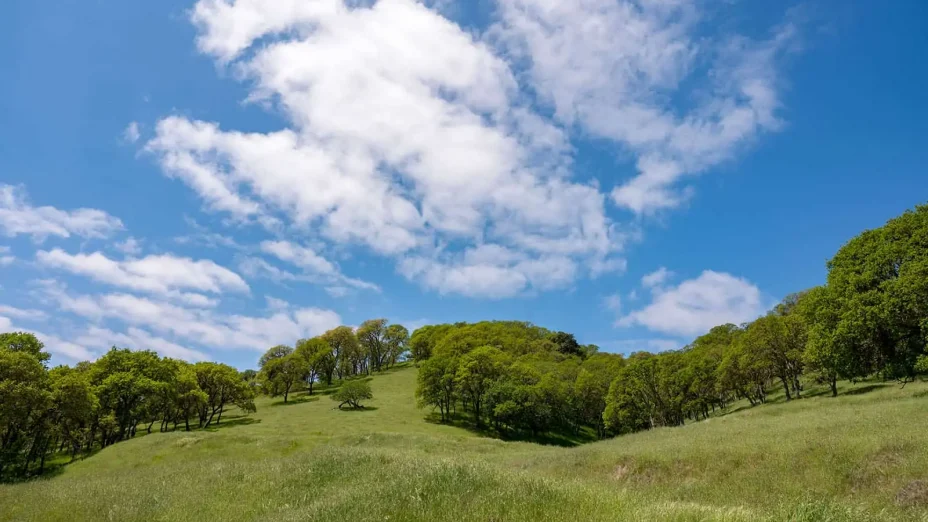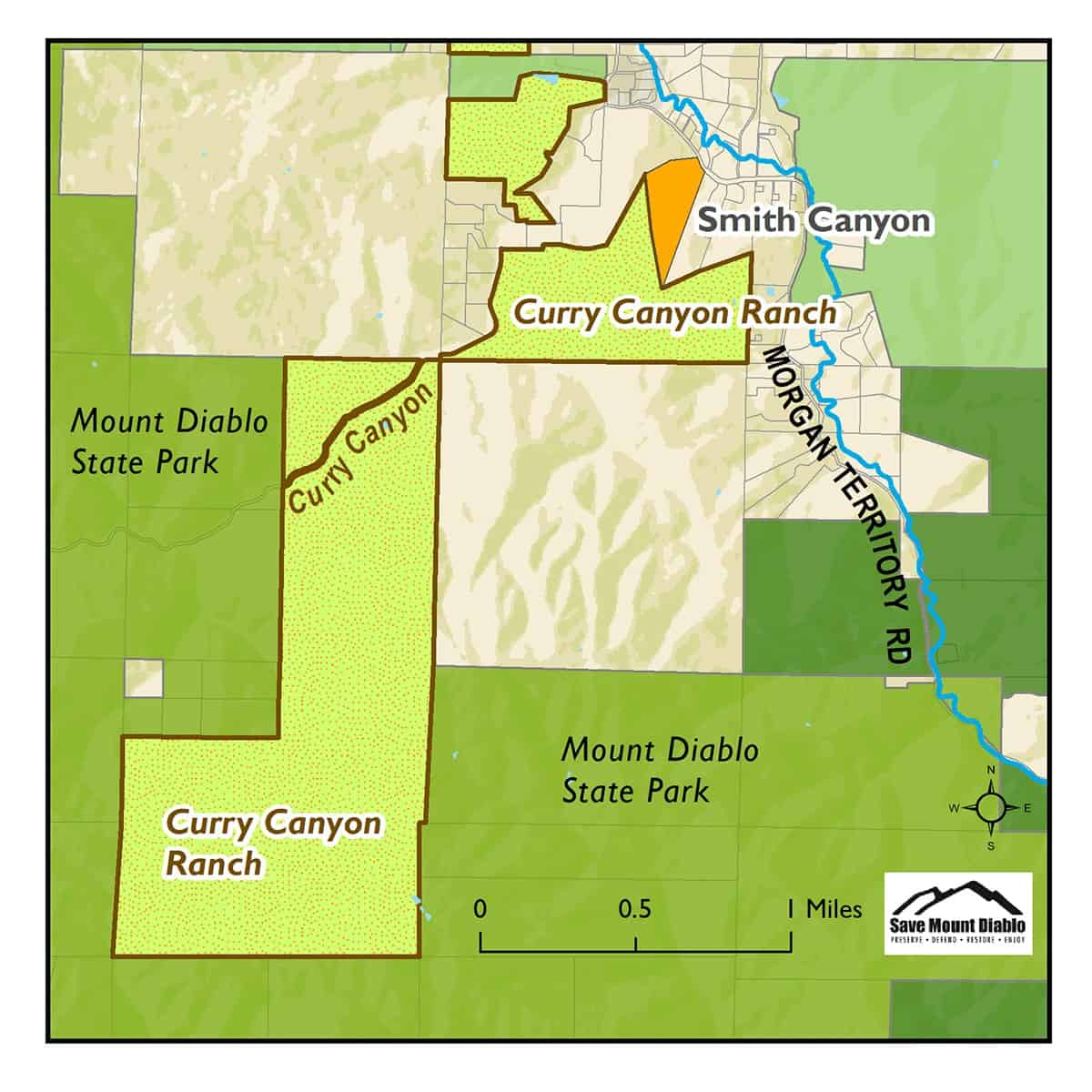
| Acreage | 28.73 acres |
|---|---|
| Watershed | Smith Canyon drains directly into Marsh Creek. |
| Vegetation communities (or habitats) | Grassland, blue oak woodland and savanna, live oak–bay riparian corridor |
| Ownership status | Protected in 2020 by Save Mount Diablo |
| Funding | Save Mount Diablo's Forever Wild Land Acquisition Fund |
Summary
Smith Canyon offers direct access from Morgan Territory Road to Curry Canyon, increasing the recreational potential of both Smith Canyon and Curry Canyon Ranch. The land is contiguous with Save Mount Diablo’s conserved Curry Canyon Ranch, so its protection adds to the important corridor of conserved lands in the Mount Diablo area, which is critical for wildlife and water resources. California red-legged frog and Alameda whipsnake are special status species likely to be present on the property. The land also affords beautiful scenic vistas to passersby on the public Morgan Territory Road.
Description
Smith Canyon could eventually be a recreational gateway to Curry Canyon and Mount Diablo State Park from Morgan Territory Road.
Protection of 28.73-acre Smith Canyon provides legal and practical access from a public road to Save Mount Diablo’s conserved 1,080.53-acre Curry Canyon Ranch.
Narrow Curry Canyon and Curry Canyon Road have been contemplated as an eastside entrance to Mount Diablo for more than 110 years, but complicated legal access issues have made public access difficult.
Smith Canyon provides a second, alternate access route into Curry Canyon with clear legal access rights.
“The Smith Canyon property is an incredible recreational gateway to the magical Curry Canyon on the east side of Mount Diablo,” said Ted Clement, SMD’s Executive Director. “But what also strikes me about the property is that it has great potential as a beautiful stand-alone preserve by itself.
“You can imagine groups of school children experiencing it, working with volunteers to replant trees to restore former building pads, taking care of the land together, and hiking its trails up to the stunning view spots where they can sit to appreciate and connect with nature. I didn’t expect the beautiful vistas of North Peak and Mount Diablo that we discovered on the high points of the land.”

“How often do you get to save an entire canyon,” said Seth Adams, SMD’s Land Conservation Director. “Smith Canyon is lovely. It’s one main lushly wooded stream canyon with several smaller drainages rising to ridges on either side and toward a small peak on our neighboring Curry Canyon Ranch.
“There were several approved subdivisions on the property that luckily never took place, but the large building pads show how threatened it has been. Its purchase is another piece in our Curry Canyon puzzle and ends that threat forever.”
 In addition to its value for recreational and other access, Smith Canyon is important from a conservation perspective. The land has blue oak woodlands, grasslands, and a live oak-bay riparian corridor.
In addition to its value for recreational and other access, Smith Canyon is important from a conservation perspective. The land has blue oak woodlands, grasslands, and a live oak-bay riparian corridor.
California red-legged frog and Alameda whipsnake are special status species likely to be present on the property. Further, the land is contiguous with Save Mount Diablo’s conserved Curry Canyon Ranch, so its protection adds to the important corridor of conserved lands in the Mount Diablo area, which is critical for wildlife and water resources. The land also affords beautiful scenic vistas to passersby on the public Morgan Territory Road.
Further, the oak woodland, oak savanna, and grasslands on the property serve as a carbon sink. In August 2019, the UN Intergovernmental Panel on Climate Change issued a new report, Climate Change and Land, that focused on how land is under increased pressure from humans and climate change but also noted land is a critical part of the solution to climate change. Land conservation mitigates against climate change in lasting ways. For example, forests and other undeveloped lands absorb greenhouse gases, thereby acting as carbon sinks, keeping those gases out of the atmosphere.
“We’re looking for angels,” said Karen Ferriere, SMD’s Development Director, about the need to raise the $650,000 purchase price and replenish the acquisition funds that were used to cover the real estate closing, “and talking to everyone we can.”
History
Curry Canyon became well-known to generations of East Bay residents visiting the Curry Creek Park picnic area, which operated from 1925 to 1979, and then to the present day as a small trailer park. Sylvester Olofson, his wife Louise, and his brother Albert Olofson bought 1,430 acres on Curry Canyon in 1895; ran cattle; and in 1925, opened Curry Creek Park. Over time Curry Canyon was divided between the two brothers’ heirs. After World War II, Curry Creek Park and neighboring Wright Canyon were owned and operated by Sylvester and Louise Olofson’s grandson, Martin Wright, and his wife, Dorothy. The larger part of the property was a cattle ranch run by Albert’s sons Raymond and Robert Olofson.
 In 1961 Ettore and Geraldine Bertagnolli bought most of the Olofson cattle ranch and renamed it Curry Creek Ranch, but it included limited access for anything but ranching.
In 1961 Ettore and Geraldine Bertagnolli bought most of the Olofson cattle ranch and renamed it Curry Creek Ranch, but it included limited access for anything but ranching.
Ettore Bertagnolli soon started proposing small subdivisions, but he was blocked by the Wrights’ ownership of the road lower in the canyon.
In 1968 he subdivided Smith Canyon off his property but retained a 60’ road easement, to be located and constructed later. He used that “paper road” to complete several subdivisions in the canyon.
Albert and Bouwina Reyenga bought Smith Canyon in 1968 and proposed a four-unit subdivision there. Roads and large building pads were graded but without professional engineering.
The subdivision was approved in 1970, but subject to various improvements including engineering improvements to the roads and pads, and paving of the access easement to the Bertagnollis’ Curry Creek Ranch. The improvements were never completed, and the approval lapsed.
The same subdivision was proposed again by the Reyengas in 1992, but building regulations had become more stringent. For the first time Save Mount Diablo was involved, requesting that a public access into Curry Canyon be reserved.
The second subdivision wasn’t completed, once again because of the cost of the roads and other building improvements. In 2000 the Reyengas sold the property to the current owners, E & B Farms, who faced similar constraints including the access easement into Curry Canyon.
In 2013 Save Mount Diablo bought the 1,080-acre Bertagnolli property and renamed it Curry Canyon Ranch. The purchase included the partly improved and unrestricted access easement up Smith Canyon. Purchase of Smith Canyon has eliminated the threat of houses and further subdivision and avoided potential conflicts with access and recreational use.
For more information, read our press release.
Save Mount Diablo’s properties are closed to the public except by guided tour.

